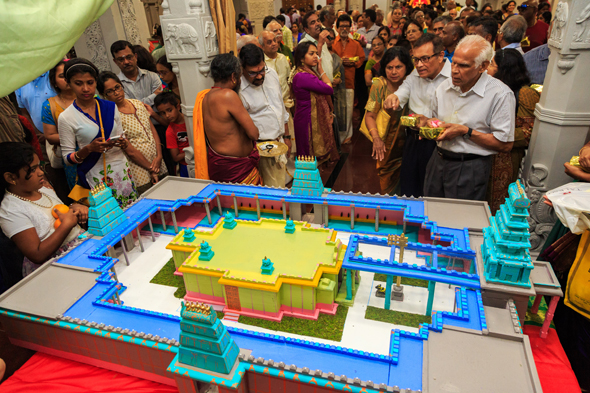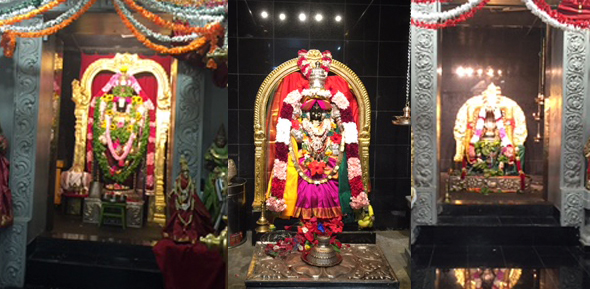Sri Meenakshi Temple Anniversary Celebrations
By Kamala Raghavan and M.K. Sriram
PEARLAND: Sri Meenakshi Temple conducted the anniversary celebrations with an auspicious “Nava Kalasa” pooja followed by Homam, Purnahuthi, and simultaneous Abhishekam, Alankaram and Aarthi to all the deities in the main temple. The event provided a feast for the eyes and ears when the images were projected at all the monitors to provide darshan to every one of the 250+ devotees who attended the event. Devotees delighted by chanting the Sri Rudra Japam, Purusha Suktham and listening to the melodious music filled with “bhakti” by visiting and local musicians. It created a tremendous enthusiasm and passion among those devotees who braved the intense heat outside to delight in getting the divine blessing. The event started at 10:00 AM on Sunday July 3, with the 9 Kalasas situated majestically on decorated platforms at the center of the main temple to invoke the deities. The priests performed Vigneswara and Vishwaksena puja, Punyahavachanam and Kalasa stapanam. The devotees were deeply moved by the vedic mantras chanted in unison by the priests Sri Balaji, Sri Paramewaran, Sri Pawan Kumar, and Sri Sriman Narayana Charlu. The whole atmosphere was filled with the strength and power of the vedic mantras. An elaborate Abhishekam and Alankaram were performed for all the deities simultaneously. When the curtains opened for darshan when the devotees were held spellbound by the majestic forms of the deities. The final Aarthi was conducted and this was followed by Prasadam and lunch distribution. Many devotees offered a wide variety of prasadams lovingly prepared in their homes. All in all, this was a very uniquely divine event where pujas and abhishekams were conducted simultaneously to Lord Sundareswara, Goddess Meenakshi, Lord Venkateswara and Goddess Padmavathy, very well organized and conducted by the Religious Activities Committee (RAC) members and devotee volunteers. The members of the Corner Temple Renovation Project (CTRP) fund raising committee explained the scope and status of the project to the assembled devotees. A brief description of the “Kalasa pooja” from the website is given below for information of the devotees.
Kalasa: A brass, mud, copper, or silver pot is filled with water. Mango leaves are placed in the mouth of the pot and a coconut is placed over it. A red or white thread is tied around its neck or sometimes all around it in an intricate diamond-shaped pattern. The pot may be decorated with designs. When the pot is filled with water or rice, it is known as purnakumbha representing the inert body which when filled with the divine life force gains the power to do all the wonderful things that makes life what it is.
Purnakumbha literally means a “full Pot” (Purna = full, Kumbha = Pot), and it is a pot full of water, with fresh leaves of the mango tree and a coconut (Sriphala) placed on the top. Purnam means completion and the significance is that the endeavor undertaken must be successfully completed. The Purnakumbha is considered a symbol of abundance and “source of life” in the Vedas. Purna-Kumbha is preeminently a Vedic motif, known from the time of Rig-Veda. The Purnakumbha is believed to be a symbol of auspiciousness embodying either Ganesha, remover of obstacles, or his mother Gauri, the goddess of household bounty or Lakshmi, the goddess of wealth. During the Samudramanthan or great churning of the milky ocean by devas and asuras to get the divine nectar, Lord Vishnu appeared bearing the pot of nectar which blessed one with everlasting life. Thus the Kalasa also symbolizes immortality.
The Kalasa (or Kalash) is used for creating seat for invoked deities during the puja. It is filled with water and topped with leaves of mango tree or betel vine to denote deity’s seat. The water inside the Kalasa keeps this seat pure till the ritual of Pranapratishta (invoking deity into an image, idol, coconut or betelnut). A coconut is set up on the mouth of the kalash after putting betel nut or coins in the water as a symbol of sacrifice. Five precious stones like pearl, diamond, emerald, blue sapphire, ruby and gold may also be added to the water of kalash, because the precious stones and gold have capacity to attract and emit the principles of five superior deities.
The neck of the pot is tied with a white, yellow or red colored thread or cloth. The water is pure and clean to the highest extent. The water in the kalash symbolizes the primordial water from which the entire creation emerged, the leaves and coconut represent creation, and the thread represents the love that “binds” all in creation. The Kalasa is therefore considered auspicious and worshipped. The waters from all the holy rivers, the knowledge of all the Vedas and the blessings of all the deities are invoked in the Kalasa and its water is thereafter used for all the rituals, including the abhishekam.
Source: bharathkidilse.blogspot.com/2009/10/kalasha.html


